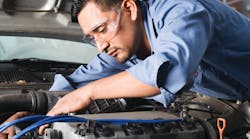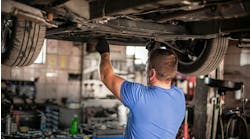It can be said without debate that current use of eye protection in the workplace has long been driven by OSHA regulations and by employers practicing good risk management. Every day an estimated 1,000 eye injuries occur in American workplaces and the financial cost of these injuries are enormous - more than $300 million per year in lost production time, medical expenses and workers comp.
Employees have long thought of eye protection usage as a mandate and typically only consider the benefits of wearing protection after an accident occurs.
Are we to fault the user solely for this lack of compliance?
While the Bureau of Labor Statistics reports that nearly 60 percent of workers injured reported are not wearing eye protection at the time of the accident, the other 40 percent of those injured were wearing some form of eye protection at the time the accident occurred.
Eye protection has long been uncomfortable, ill-fitting and manufactured without thought or consideration for the varied needs of the user. Today, advancements in safety features and the drive for making eyewear more comfortable and adjustable for the individual wearer, make compliance in the workplace an easier task for the user.
INADVERTENT RISKS
All of these choices, however, do create an unintended consequence: With so many choices, how do I choose the right kind of eye protection?
- Analyze the environmental threats. It is of outmost importance that every risk is considered, analyzed and matched to the appropriate eyewear product.
Fleet maintenance professionals must consider not just impact protection but also chemical splash exposure, airborne dust and particulates, as well as heat exposure and optical radiation (light). Every risk, no matter how small the probability, should be treated with equal importance.
- Match the threat with protection features. The fleet maintenance professional’s toolbox has many tools that at first glance perform the same function, but you know different, right? The same goes for eye protection.
The toolbox should have more than one pair of safety glasses, goggles or full-face mask protectors, because you will not find one product that will meet all of your needs.
The American National Standards Institute’s Z87.1-2010 standard for safety eyewear goes a long way toward defining how a product should perform. However, it is important to look for “beyond compliance” features that will ensure a product will afford the greatest level of protection for the user, while at the same time providing comfort, fit and style that drive compliance from the wearer.
- Don’t skimp on safety. There is an abundance of low-cost, sub-standard products that lack proper certification from a third-party testing and certification center.
As a manufacturer, this can be costly. But ultimately it assures the user of the quality of the product, as well as ensures that the manufacturer is committed to providing the safest products on the market.
- Special features to accommodate every user. Talk to a safety professional for assistance with the different features available.
For safety eyeglasses, consider lens tinting options for indoors and outdoors, as well as tinting that offers protection while cutting and grinding steel.
Careful consideration must be given to fit and comfort, and features such as extended and ratcheting temples, wide, narrow or adjustable nosepieces may require you to try before you buy.
Reader options are now available for safety eyeglasses that offer magnification levels for most users.
As an employer, you may want to consider a prescription safety eyewear program. These are offered by many safety distributors.
Women in the workplace also deserve eye protection with a fit that is optimized for their features, and offers a more feminine look.
For cutting and grinding steel, consider eyewear with foam lining that meets Fire Retardant (FR) standards, and lenses that offer IR (infrared radiation) 3.0 or 5.0 protection, depending on the use.
For chemical splash and hazardous contaminant safety goggles, proper fit around the face and the appropriate venting and air circulation options are highly important considerations.
For someone that wears prescription glasses, consider a model that is roomy enough to accommodate the glasses, or a model that accommodates a prescription lens insert.
Lastly, great advances have been made in lens coatings to offer anti-scratch and anti-fogging solutions. An eyeglass or goggle that has fogged up offers little to no safety, and very often becomes a worse hazard to the user, so a lens that offers a truly fog-free solution is our goal as a manufacturer.
Current lens coatings and cleaning products with anti-fog properties is a desirable feature to consider.
NOT JUST FOR WORK
Eye injuries that occur off the job cost individuals and their employers billions of dollars each year in medical care and lost productivity.
As a manufacturer, Encon Safety Products has strived to offer a line of products that offers beyond compliance safety features to include style and comfort characteristics that will encourage the user to wear our products not just at work, but also at home and at play.
Whether you are servicing a 5,000-pound diesel engine, mowing your lawn, or enjoying a ride on your motorcycle or a cruise in your boat, we encourage you to make safety eyewear a part of your everyday life - for yourself, your family and your livelihood.
Cindi Naylor is the PPE business manager and Joe Martinez is a marketing manager for Encon Safety Products, a manufacturer of market-leading first-aid emergency shower and eyewash products, personal protective equipment, including safety eye wear, goggles and hearing protection, and hazardous-area storage cases for the protection and security of people, plant and equipment. www.enconsafety.com.



